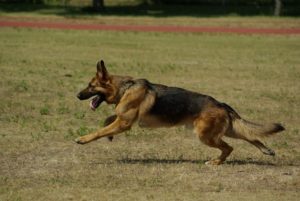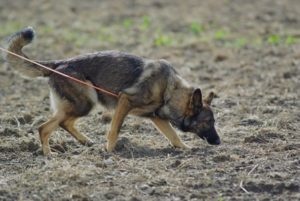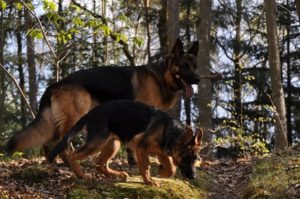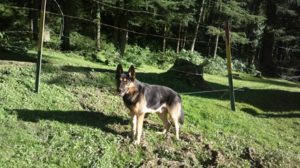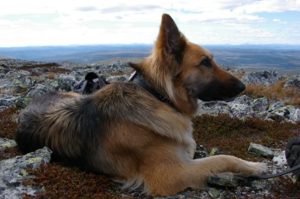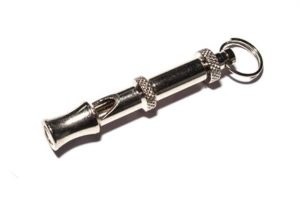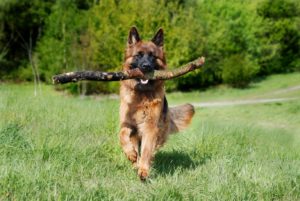German Shepherds were originally used for herding sheep and protecting them from bears and wolves. Since they are large, strong, and incredibly intelligent dogs with innate guarding and fighting skills, you’re probably wondering if GSDs can hunt ducks or track deer?
German Shepherds are immensely devoted to the owner, very smart, easily trainable, and perform dangerous tasks. They are very intelligent dogs, and they can learn to track deer if you teach them correctly.
Training your German Shepherd in tracking, trailing, and hunting is not something you can do over a few days or a week. It is a time-consuming process that will need more than just one hour of your day.
Nevertheless, suppose you are patient enough and eager to teach your dog every necessary skill so they could make you proud in the field. In that case, this article will help you on your way.
However, it is worth mentioning that some are not suitable for this activity as some German Shepherds have been bred/trained for only being show dogs.
Can They Track Deer?
Dogs are, of course, the most famous animals with a strong sense of smell, as their abilities are a hundred times better than that of humans. This is true for all dogs. However, the German Shepherd is more obedient than the average dog.
According to research, the nose of a German Shepherd contains about 50 million olfactory cells. That’s not all; the olfactory bulb in their brains is also larger than most dogs.
They are versatile dogs and make up about half of all detective dogs. They are equally good at finding explosives and drugs and are ideal for capturing and escorting criminals.
A German shepherd can track deer if you train him to do so.
The fact that they are used in the police is more than enough to understand that they have a great sense of smell. Moreover, German shepherd dogs are sometimes better suited to work in difficult weather conditions.
German Shepherds are known to be good dogs for tracking. They are athletic and have high energy, work for hours, and have strong obedience skills. These traits are abundant in GSDs, which is one reason they make excellent tracking dogs.
How Can They Track Deer?
German Shepherds are known for tracking down deer, but how exactly do they do it? The tracking process happens with no effort or thought on your part, so it can be easy to assume that dogs have an acute sense of smell.
German Shepherds, like all members of their canine family, actively use their sense of smell. As soon as your German Shepherd catches the first signs of fresh air, his moist and spongy nose helps to capture any scent in the air.
The ability to sniff separately from each nostril, smelling in stereo, helps to determine the direction of the source of the smell. The dog gets to know the kind of smell present and also where it is located.
Within the first few moments of sniffing, the dog not only begins to know what kind of smell there is, but rather where they are located.
Landmarks like bushes and trees are aromatic signals sending messages of a deer’s location.
There are many methods to train them.
Training To Track The Deer’s Hide Scent
Take your German Shepherd to swampy areas where his sense of smell will work best. Hide the treats at a smaller distance. Grind the treats under your shoes and walk between the goodies to create a trail of scent.
Take your German Shepherd off-leash and let him follow the trails. If he follows the course of scent, praise him; otherwise, ignore him.
You can also create a trail by a deer hide. Leave treats somewhere between tracks so that your German Shepherd feels motivated to follow the trail.
Gradually remove the treats and just let him follow the deer scent. If he’s able to locate the deer’s hide, reward him and praise him.
Teach your dog to speak on command when he tracks the deer down. After some time, he will give you a signal on his own by barking.
Training To Track Deer’s Blood Trails
German Shepherds can sense one drop of blood in 5 liters of water. So, this is one of the most effective ways to train. You can make him familiar with deer blood by putting it on a sponge or clothes. When he investigates it, praise him. He will become familiar with deer blood.
For starters, create a deer blood trail in a straight line and let him follow it. Place a treat at the end of the course so that he can feel motivated.
Gradually you can create trails that are not continuous, are longer, and are complicated. Tell them the direction when they get off the trail.
Once they find the deer’s hide on the other end, praise and reward him with treats.
Training To Track The Deer’s Hide Scent
Turns out that GSD puppies learn better with their older brothers that already know how to hunt. He tries to imitate others so that he can also be praised and rewarded. This motivates him, and he can learn it quickly.
Let another trained dog take the lead and find the deer hide. Your new trainee will learn from him and try to track him down on his own.
Do not forget to praise and reward him if he does the right thing.
Are They Good With Birds?
German Shepherds are widely considered to be the most versatile dogs out there, and rightfully so. From K-9 units to assistance dogs, the list of uses is pretty impressive. While breeds exist that are specifically bred as bird hunting dogs, German Shepherds are not among them.
You can train German Shepherds to hunt ducks, but they are not hunting dogs. They cannot perform like hunter-dogs in the case of hunting. However, you can train them to retrieve the carcasses of ducks.
What Makes Them Good or Bad at Hunting?
The German Shepherd is one of those breeds characterized by its intelligence, making them a versatile dog capable of being a guardian, shepherd, companion, and much more.
However, the German Shepherd does not belong to the category of hunting dogs. They were primarily sheepdogs.
German Shepherds tend to bark at deer and scare them away.
You can use them for tracking as they have great sense and are relatively more obedient than other breeds.
GSDs can be great working dogs, but if you need a companion, especially for hunting, they are not the best choice you can find.
How To Train a German Shepherd To Hunt
Before you start training your German Shepherd to hunt, you should also make sure of their safety. A dog in the forest behaves very differently than at home. Usually, in nature, animals become more active. They run around, sniff various objects, and show great interest in new surroundings.
In such a situation, there is a possibility that he will get separated from you. You wouldn’t want that at all. So there are few steps that you can take to ensure that it never happens.
Taking Your GSD in the Woods for the First Time
Before the first outing in the forest, the puppy must undergo an initial training course at home. He must be able to carry out elementary commands and be able to respond to his nickname. Disobedience in the forest can create many problems for both the owner and the pet. Often this becomes the reason for the disappearance of the dog.
Before stepping into the forest area, you must foresee the dangers such as ticks and mites, or snakes.
Ticks and mites
Ticks are a significant hazard during forest walks. They are carriers of serious diseases – tick-borne encephalitis and borreliosis. Therefore, 2-3 days before walking or hunting, it is useful to use drops or aerosol against forest parasites. You can put a special anti-mite collar on your pet.
However, such products do not always protect against bites. Therefore, after each exit into the forest, you need to carefully examine the wool. If you find a tick, you do not need to try to remove it yourself. It is better to seek help from a veterinary clinic.
Snakes
When encountering a snake, the dog usually tries to grab it. In this case, pets often get bites. Therefore, you need to have antihistamines with you. This is the first aid for the defeat of snake venom. Then the dog needs to be urgently taken to the veterinary clinic. The specialist will inject the animal with a special serum.
In no case should you hit the snake and try to drive it away. Otherwise, she can switch her aggression from a dog to a person. And for humans, snake bites are much more dangerous than for animals. Dogs are more resistant to viper venom.
What To Do If You Lose Your Dog?
How to find a dog in the forest? Often, the owners panic and do the wrong thing. They start running around the area, looking for and calling for a pet. When a person moves erratically, the dog loses track.
You need to stand in the same place and call the dog loudly. In most cases, the pet returns to the owner. If you stepped aside, then you need to follow in your footsteps back.
What if the dog does not return even after repeated calls? You can leave your item or a dog’s toy at the place of his loss. The next day you need to return to the forest at the same location. Often, this search method helps locate a missing pet. The animals returned, guided by the smell of a familiar thing.
To avoid losing the dog in the forest, it is necessary to conduct special exercises with the puppy. During a walk, it is recommended to periodically disappear from the animal’s field of view, for example, to hide behind a tree. In doing so, you should always see your pet. This will force the dog to look for you. In the future, the dog will be afraid to lose sight of you and will stick around.
It is also helpful to engrave your phone number on a metal plate and attach it to his collar. Often, dogs that have disappeared in the forest are found in the nearest towns or villages.
Basic command training
Outdoor training should be preceded by home teaching of dog commands. Of course, first, the puppy is taught his nickname. Together with them, you can start teaching the command “Come to me!”. To do this, you need to affectionately call a nickname, say “Come to me!” and show with your hands that you are waiting for them. As soon as the pet comes up, you need to treat him and praise him. All commands are pronounced in a calm tone without increasing intonation. Otherwise, the puppy may get scared and, in the future, constantly doubt his actions.
It is very important to raise a pet so that he knows where he belongs. If the puppy obeys the command but then suddenly jumps off and tries to run away, you need to show your perseverance and stop him with your hand. It is persistence, not importunity, that is important in upbringing. If you exclude treats, praise, and play from the upbringing process, the puppy will lose all interest and stop doing anything.
Team “Fu!” (or “No!”) should also be familiar to the pet from the first days. After completion, a treat should also follow. These examples give you a clear idea of how to train your dog at home.
At about 3 months old, a collar and leash are put on the puppy. At first, he will try to remove the collar, but he will get used to it over time. On a leash, try to keep the puppy close to your leg and stop his attempts to escape. From 6 months old, the puppy learns to walk strictly next to it, always on the owner’s left side. It is important to control your GSD and not let him play with the leash. He must understand that this is not a toy. After the pet has learned this command, you can release it from the leash and train without it.
Whistle Commands Training
It is advisable to choose ultrasonic whistles for hunting dogs that are audible to the animal but not audible to others for training.
Any command to the dogs on the hunt can be reinforced with a whistle, then the pet will get used to it faster. It is important not to use the whistle after the animal has been punished. Otherwise, the pet will associate the whistle with the threat of being punished.
Disporting Command Training
This command can also be trained in an apartment.
First, you need to give the pet the opportunity to get used to the action of carrying something in his mouth. After a while, you should call the puppy and ask him to give you the thing. If he does not give up the item, you can pick it up yourself. After that, be sure to treat your four-legged friend. If the training of a hunting dog takes place on the street, you need to throw an object into the water from time to time so that he will bring it from there. It is necessary to accustom the animal to water. This is very important for German Shepherds. This command will be useful for hunting dogs much more than others.
Ground search training
The main thing here is to teach the pet to move correctly and look for games.
It is important that the dog has a developed instinct and can look for an animal against the wind. Otherwise, he will only be able to track down the animal but not find it. So, moving with the owner, the pet must cross his path from left to right. In this case, the hunter must stop the pet’s movement with a whistle and show with his hand the direction for further movement. When whistling, the animal turns around and continues to search for the game. The ideal place for training is the wide swampy area.


